Effects of Electron Beam Irradiation on Mechanical and Tribological Properties of PEEK
Abstract
1. Introduction
2. Materials and Methods
2.1. Electron Irradiation
2.2. Tribological Test
2.3. Wear Rate
2.4. Microhardness
2.5. X-ray Diffraction (XRD)
2.6. DSC and TGA Analysis
3. Results and Discussion
3.1. Electron Irradiation
3.2. Effects of Electron Beam Irradiation on Friction Coefficient, Wear Rate, and Microhardness
3.3. XRD Spectra
3.4. TGA and DSC Analysis
4. Conclusions
Author Contributions
Funding
Data Availability Statement
Acknowledgments
Conflicts of Interest
References
- Arif, M.F.; Kumar, S.; Varadarajan, K.M.; Cantwell, W.J. Performance of biocompatible PEEK processed by fused deposition additive manufacturing. Mater. Des. 2018, 146, 249–259. [Google Scholar] [CrossRef]
- Friedrich, K.; Almajid, A.A. Manufacturing aspects of advanced polymer composites for automotive applications. Appl. Compos. Mater. 2013, 20, 107–128. [Google Scholar] [CrossRef]
- Shah, D.; Karibayev, M.; Adotey, E.K.; Amouei Torkmahalleh, M. Impact of volatile organic compounds on chromium containing atmospheric particulate: Insights from molecular dynamics simulations. Sci. Rep. 2020, 10, 1–9. [Google Scholar]
- Carbone, A.; Castriciano, M.A.; Monsù Scolaro, L.; Gatto, I. Novel Polymeric Composite TPPS/s-PEEK Membranes for Low Relative Humidity PEFC. Polymers 2020, 12, 1431. [Google Scholar] [CrossRef]
- Kim, D.J.; Choi, D.H.; Park, C.H.; Nam, S.Y. Characterization of the sulfonated PEEK/sulfonated nanoparticles composite membrane for the fuel cell application. Int. J. Hydrog. Energy 2016, 41, 5793–5802. [Google Scholar] [CrossRef]
- Beyraghi, F.; Mirfarsi, S.H.; Rowshanzamir, S.; Karimi, A.; Parnian, M.J. Optimal thermal treatment conditions for durability improvement of highly sulfonated poly (ether ether ketone) membrane for polymer electrolyte fuel cell applications. Int. J. Hydrog. Tnergy 2020, 45, 13441–13458. [Google Scholar] [CrossRef]
- Zhang, T.; Liu, H.; Zhang, D.; Chen, K. Mechanical and wear properties of polyetheretherketone composites filled with basalt fibres. Sci. Eng. Compos. Mater. 2019, 26, 317–326. [Google Scholar] [CrossRef]
- Liu, H.; Mei, Q.; Ding, G.; Xiao, H.; Chen, S.; Huang, Z. Preparation of PEEK-NH2/graphene network structured nanocomposites with high electrical conductivity. e-Polymers 2022, 22, 763–774. [Google Scholar] [CrossRef]
- Wang, Y.; Shen, J.; Yan, M.; Tian, X. Poly ether ether ketone and its composite powder prepared by thermally induced phase separation for high temperature selective laser sintering. Mater. Des. 2021, 201, 109510. [Google Scholar] [CrossRef]
- Hao, L.; Hu, Y.; Zhang, Y.; Wei, W.; Hou, X.; Guo, Y.; Hu, X.; Jiang, D. Enhancing the mechanical performance of poly (ether ether ketone)/zinc oxide nanocomposites to provide promising biomaterials for trauma and orthopedic implants. RSC Adv. 2018, 8, 27304–27317. [Google Scholar] [CrossRef]
- Ning, L.; Deqiang, C.; Xiyan, G.; Lirong, L.; Weizeng, C. Biological tribology properties of the modified polyether ether ketone composite materials. Rev. Adv. Mater. Sci. 2020, 59, 399–405. [Google Scholar] [CrossRef]
- Mikšová, R.; Macková, A.; Malinský, P.; Slepička, P.; Švorčík, V. A study of the degradation of polymers irradiated by Cn+ and On+ 9.6 MeV heavy ions. Polym. Degrad. Stab. 2015, 122, 110–121. [Google Scholar] [CrossRef]
- Kalia, R.; Sharma, J.K.; Kalia, S. Swift heavy ion irradiation effects on dielectric constant and dielectric loss in poly (ether ether ketone)(PEEK). Adv. Mater. Proc. 2018, 3, 146–150. [Google Scholar] [CrossRef]
- Kalia, R.; Sharma, V.; Mahna, S.K.; Sharma, J.K. Dielectric relaxation behavior of C 5+(70 MeV) swift heavy ion irradiated polyetheretherketone (PEEK) using TSDC technique. Polym. Sci. Ser. A 2014, 56, 837–843. [Google Scholar] [CrossRef]
- Khare, N.; Limaye, P.K.; Soni, N.L.; Patel, R.J. Gamma irradiation effects on thermal, physical and tribological properties of PEEK under water lubricated conditions. Wear 2015, 342, 85–91. [Google Scholar] [CrossRef]
- Chai, L.; Ning, K.; Qiao, L.; Wang, P.; Weng, L. Comparative study on microstructure, mechanical, and tribological property of gamma-irradiated polytetrafluoroethylene, polyetheretherketone, and polyimide polymers. Surf. Interface Anal. 2022, 54, 13–24. [Google Scholar] [CrossRef]
- Quan, D.; Deegan, B.; Binsfeld, L.; Li, X.; Atkinson, J.; Ivanković, A.; Murphy, N. Effect of interlaying UV-irradiated PEEK fibres on the mechanical, impact and fracture response of aerospace-grade carbon fibre/epoxy composites. Compos. Part B: Eng. 2020, 191, 107923. [Google Scholar] [CrossRef]
- Fathy, S.M.; Emera, R.M.K.; Abdallah, R.M. Surface Microhardness, Flexural Strength, and Clasp Retention and Deformation of Acetal vs Poly-ether-ether Ketone after Combined Thermal Cycling and pH Aging. J. Contemp. Dent. Pract. 2021, 22, 140–145. [Google Scholar] [CrossRef] [PubMed]
- Paulmier, T.; Dirassen, B.; Arnaout, M.; Payan, D.; Balcon, N. Radiation-induced conductivity of space used polymers under high energy electron irradiation. IEEE Trans. Plasma Sci. 2015, 43, 2907–2914. [Google Scholar] [CrossRef]
- Liu, Z.; Wang, L.; Hou, X.; Wu, J. Investigation on dielectrical and space charge characteristics of peek insulation used in aerospace high-voltage system. IEEJ Trans. Electr. Electron. Eng. 2020, 15, 172–178. [Google Scholar] [CrossRef]
- Sasuga, T.; Seguchi, T.; Sakai, H.; Nakakura, T.; Masutani, M. Electron-beam irradiation effects on mechanical properties of PEEK/CF composite. J. Mater. Sci. 1989, 24, 1570–1574. [Google Scholar] [CrossRef]
- Sasuga, T.; Hagiwara, M. Mechanical relaxation of crystalline poly (aryl-ether-ether-ketone)(PEEK) and influence of electron beam irradiation. Polymer 1986, 27, 821–826. [Google Scholar] [CrossRef]
- Frick, A.; Sich, D.; Heinrich, G.; Lehmann, D.; Gohs, U.; Stern, C. Properties of melt processable PTFE/PEEK blends: The effect of reactive compatibilization using electron beam irradiated melt processable PTFE. J. Appl. Polym. Sci. 2013, 128, 1815–1827. [Google Scholar] [CrossRef]
- Jeun, J.P.; Nho, Y.C.; Kang, P.H. Enhancement of mechanical properties of PEEK using radiation process. Appl. Chem. 2008, 12, 245–248. [Google Scholar]
- Komai, K.; Minoshima, K.; Tanaka, K. Influence of Electron Radiation on Tensile and Impact Fracture Mechanism of Carbon/PEEK Composite. Trans. Jpn. Soc. Mech. Eng. Ser. A 1998, 64, 2300–2307. [Google Scholar] [CrossRef]
- Li, H.; Yang, J.; Tian, F.; Li, X.; Dong, S. Study on the Microstructure of Polyether Ether Ketone Films Irradiated with 170 keV Protons by Grazing Incidence Small Angle X-ray Scattering (GISAXS) Technology. Polymers 2020, 12, 2717. [Google Scholar] [CrossRef] [PubMed]
- Chai, L.; Zhang, B.; Qiao, L.; Wang, P.; Weng, L. Influence of gamma irradiation-induced surface oxidation on tribological property of polyetheretherketone (PEEK). Polym. Bull. 2021, 79, 6513–6531. [Google Scholar] [CrossRef]
- Mylläri, V.; Ruoko, T.P.; Järvelä, P. The effects of UV irradiation to polyetheretherketone fibres–Characterization by different techniques. Polym. Degrad. Stab. 2014, 109, 278–284. [Google Scholar] [CrossRef]
- Kornacka, E.M.; Przybytniak, G.; Nowicki, A. Radical processes initiated by ionizing radiation in PEEK and their macroscopic consequences. Polym. Adv. Technol. 2019, 30, 79–85. [Google Scholar] [CrossRef]
- Auslender, V.L.; Bukin, A.D.; Voronin, L.A.; Kokin, E.N.; Korobeinikov, M.V.; Krainov, G.S.; Lukin, A.N.; Radchenko, V.M.; Sidorov, A.V.; Tkachenko, V.O. Bremsstrahlung converters for powerful industrial electron accelerators. Radiat. Phys. Chem. 2004, 71, 297–299. [Google Scholar] [CrossRef]
- Almas, N.; Kurbanova, B.; Zhakiyev, N.; Rakhadilov, B.; Sagdoldina, Z.; Andybayeva, G.; Serik, N.; Alsar, Z.; Utegulov, Z.; Insepov, Z. Mechano-chemical properties of electron beam irradiated polyetheretherketone. Polymers 2022, 14, 3067. [Google Scholar] [CrossRef] [PubMed]
- Lin, Z.; Yue, H.; Gao, B. Enhancing tribological characteristics of PEEK by using PTFE composite as a sacrificial tribofilm-generating part in a novel dual-pins-on-disk tribometer. Wear 2020, 460, 203472. [Google Scholar] [CrossRef]
- Panin, S.V.; Nguyen, D.A.; Buslovich, D.G.; Alexenko, V.O.; Pervikov, A.V.; Kornienko, L.A.; Berto, F. Effect of various type of nanoparticles on mechanical and tribological properties of wear-resistant peek+ ptfe-based composites. Materials 2021, 14, 1113. [Google Scholar] [CrossRef] [PubMed]
- Lin, Z.; Qu, T.; Zhang, K.; Zhang, Q.; Wang, S.; Wang, G.; Gao, B.; Fan, G. Modeling of contact temperatures and their influence on the tribological performance of PEEK and PTFE in a dual-pin-on-disk tribometer. Friction 2023, 11, 546–566. [Google Scholar] [CrossRef]
- Song, J.; Shi, H.; Liao, Z.; Wang, S.; Liu, Y.; Liu, W.; Peng, Z. Study on the Nanomechanical and Nanotribological Behaviors of PEEK and CFRPEEK for Biomedical Applications. Polymers 2018, 10, 142. [Google Scholar] [CrossRef]
- Lin, L.; Zhao, Y.; Hua, C.; Schlarb, A.K. Effects of the Velocity Sequences on the Friction and Wear Performance of PEEK-Based Materials. Tribol. Lett. 2021, 69, 68. [Google Scholar] [CrossRef]
- Qu, S.; Penaranda, J.; Wang, S.S. Tribological behavior of PTFE/PEEK composite. In Proceedings of the Technical Conference American Society for Composites: Thirty-First Technical Conference, Williamsburg, VA, USA, September 2016. [Google Scholar]
- Zhang, G.; Schlarb, A.K. Correlation of the tribological behaviors with the mechanical properties of poly-ether-ether-ketones (PEEKs) with different molecular weights and their fiber filled composites. Wear 2009, 266, 337–344. [Google Scholar] [CrossRef]
- Zalaznik, M.; Kalin, M.; Novak, S. Influence of the processing temperature on the tribological and mechanical properties of poly-ether-ether-ketone (PEEK) polymer. Tribol. Int. 2016, 94, 92–97. [Google Scholar] [CrossRef]
- Pooley, C.M.; Tabor, D. Friction and molecular structure: The behaviour of some thermoplastics. Proceedings of the Royal Society of London. A. Math. Phys. Sci. 1972, 329, 251–274. [Google Scholar]
- Biswas, S.K.; Vijayan, K. Friction and wear of PTFE—A review. Wear 1992, 158, 193–211. [Google Scholar] [CrossRef]
- Ovaert, T.C.; Cheng, H.S. Counterface topographical effects on the wear of polyetheretherketone and a polyetheretherketone-carbon fiber composite. Wear 1991, 150, 275–287. [Google Scholar] [CrossRef]
- Laux, K.A.; Schwartz, C.J. Influence of linear reciprocating and multi-directional sliding on PEEK wear performance and transfer film formation. Wear 2013, 301, 727–734. [Google Scholar] [CrossRef]
- Muratoglu, O.K.; Bragdon, C.R.; O’Connor, D.O.; Jasty, M.; Harris, W.H.; Gul, R.; McGarry, F. Unified wear model for highly crosslinked ultra-high molecular weight polyethylenes (UHMWPE). Biomaterials 1999, 20, 1463–1470. [Google Scholar] [CrossRef] [PubMed]
- Wang, A.; Stark, C.; Dumbleton, J.H. Mechanistic and morphological origins of ultra-high molecular weight polyethylene wear debris in total joint replacement prostheses. Proc. Inst. Mech. Eng. Part H: J. Eng. Med. 1996, 210, 141–155. [Google Scholar] [CrossRef] [PubMed]
- Wang, Y.; Beard, J.D.; Evans, K.E.; Ghita, O. Unusual crystalline morphology of poly aryl ether ketones (PAEKs). RSC advances 2016, 6, 3198–3209. [Google Scholar] [CrossRef]
- Hudson, S.D.; Davis, D.D.; Lovinger, A.J. Semicrystalline morphology of poly (aryl ether ether ketone)/poly (ether imide) blends. Macromolecules 1992, 25, 1759–1765. [Google Scholar] [CrossRef]
- Kusy, R.P.; Turner, D.T. Radiation chemistry of polymers studied by depression of melting temperature. Macromolecules 1971, 4, 337–341. [Google Scholar] [CrossRef]
- Bhateja, S.K.; Andrews, E.H.; Young, R.J. Radiation-induced crystallinity changes in linear polyethylene. J. Polym. Sci. Polym. Phys. Ed. 1983, 21, 523–536. [Google Scholar] [CrossRef]
- Sasuga, T.; Kudoh, H. Ion irradiation effects on thermal and mechanical properties of poly(ether–ether–ketone) (PEEK). Polymer 2000, 41, 185–194. [Google Scholar] [CrossRef]
- Rival, G.; Paulmier, T.; Dantras, E. Influence of electronic irradiations on the chemical and structural properties of PEEK for space applications. Polym. Degrad. Stab. 2019, 168, 108943. [Google Scholar] [CrossRef]
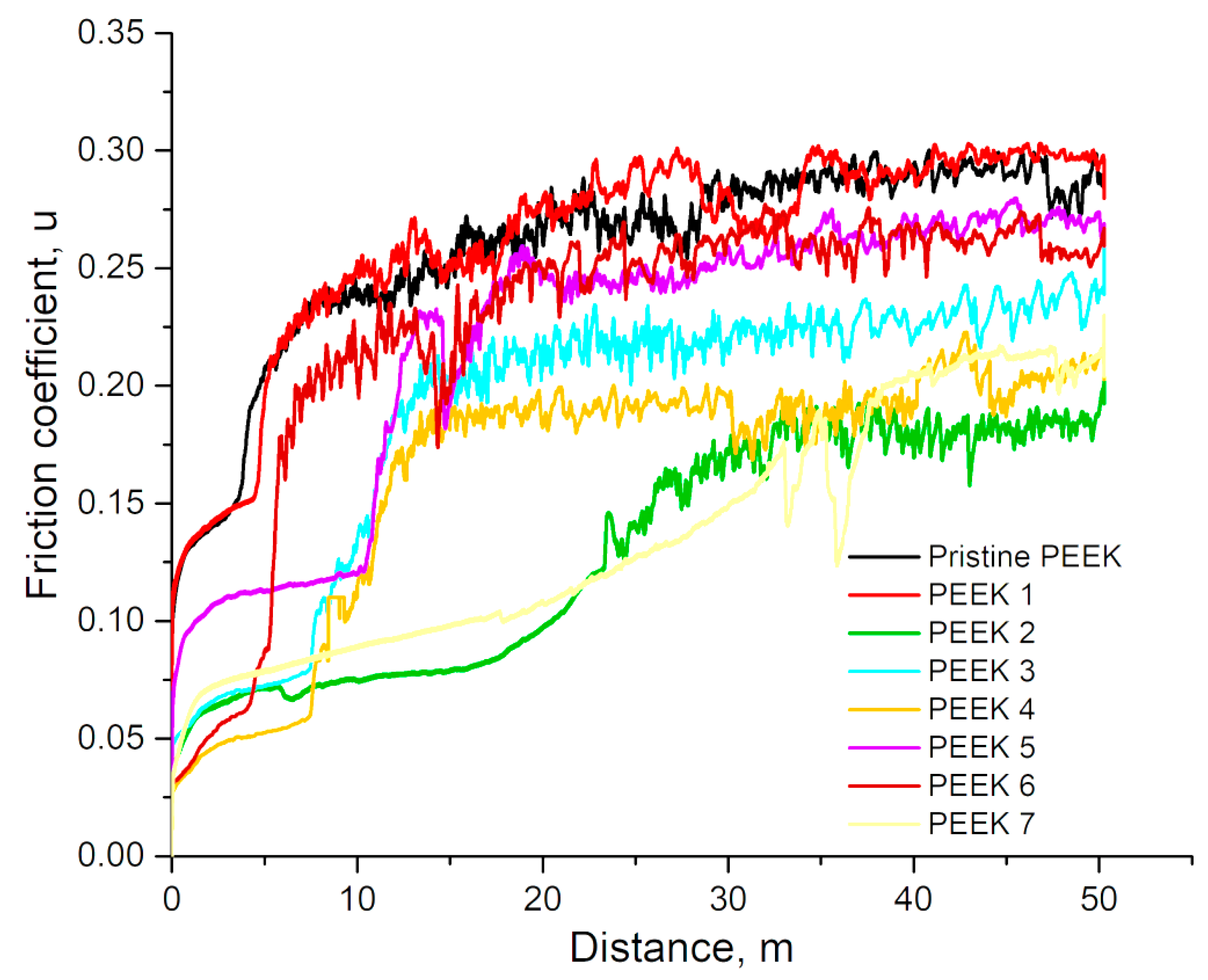


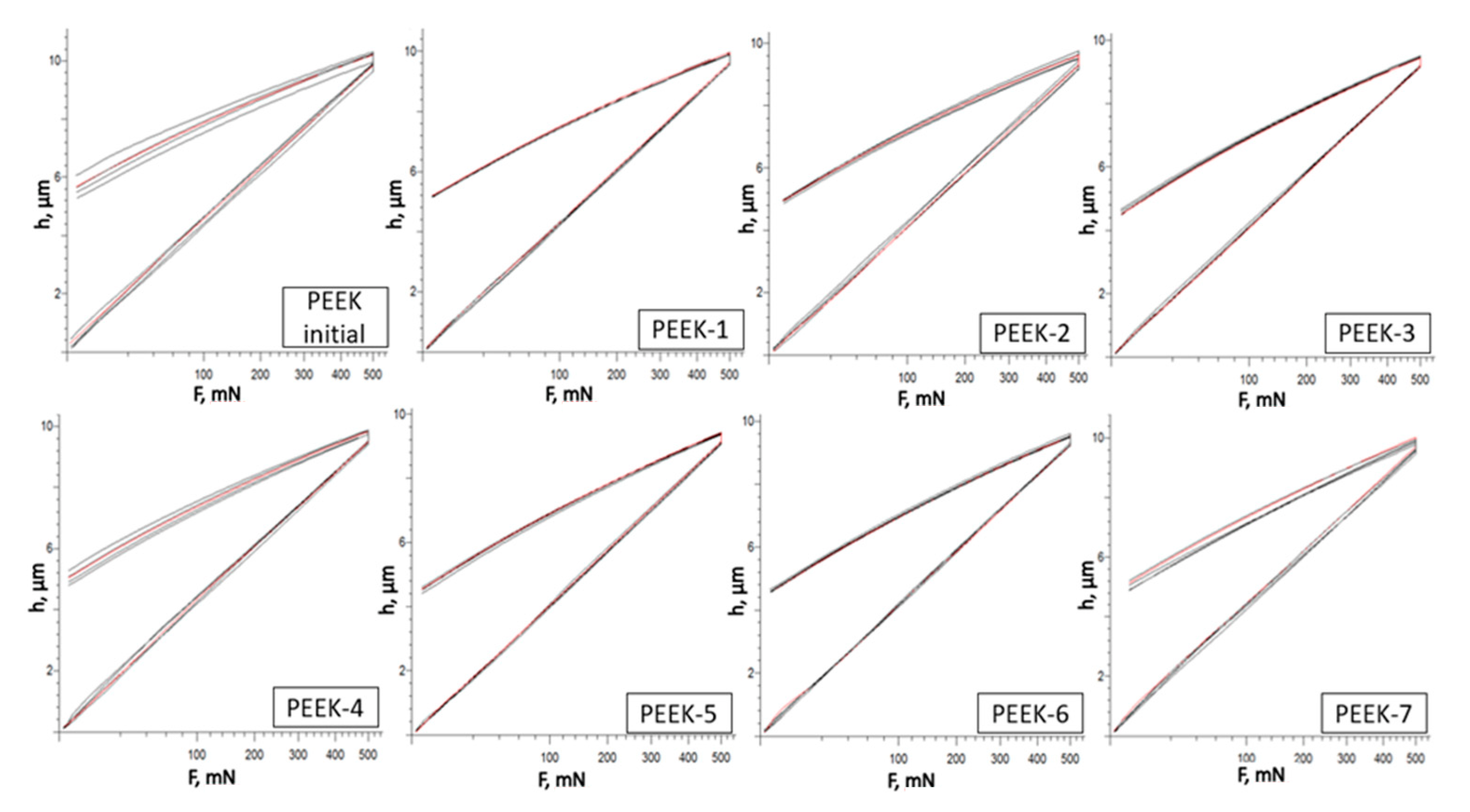

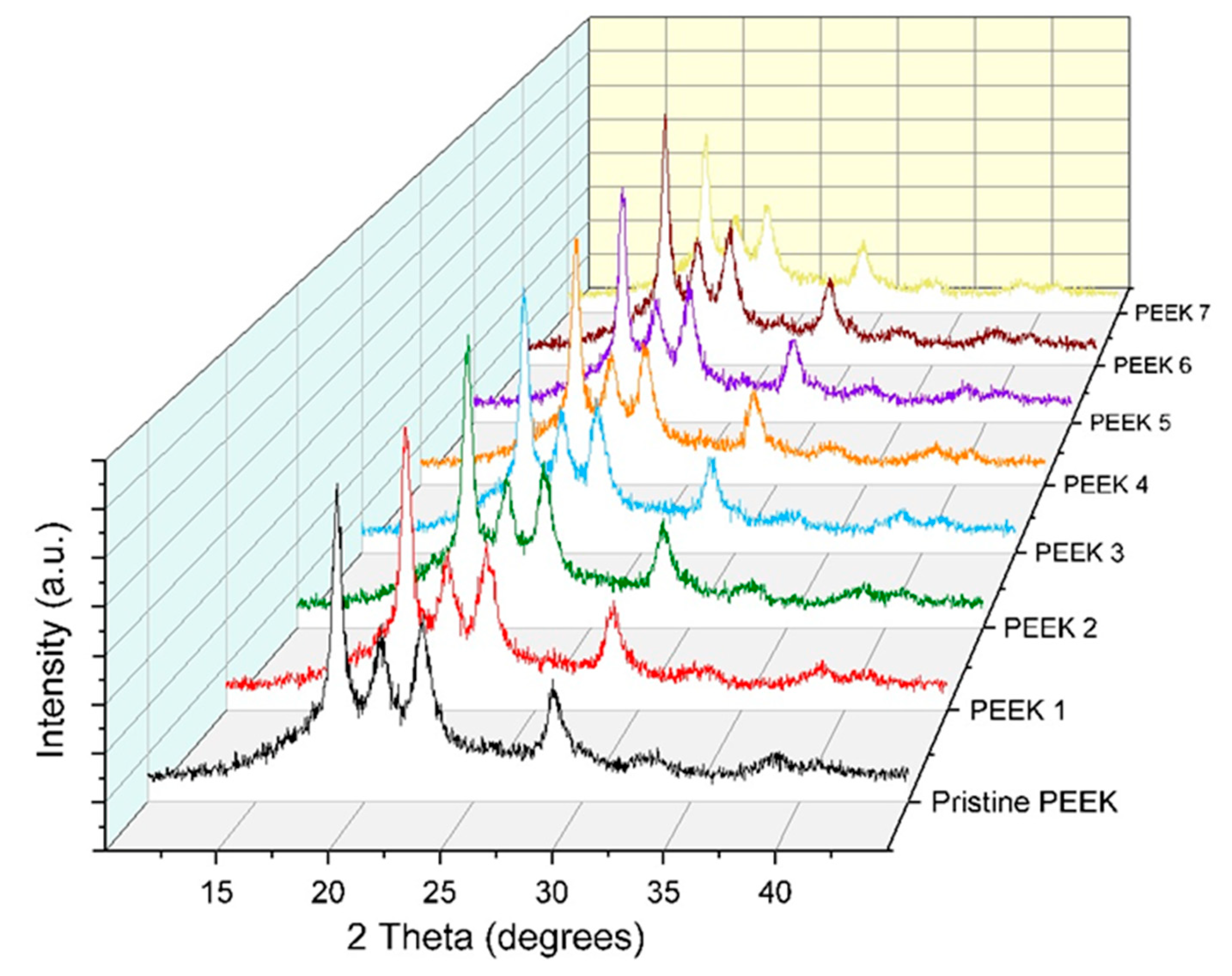
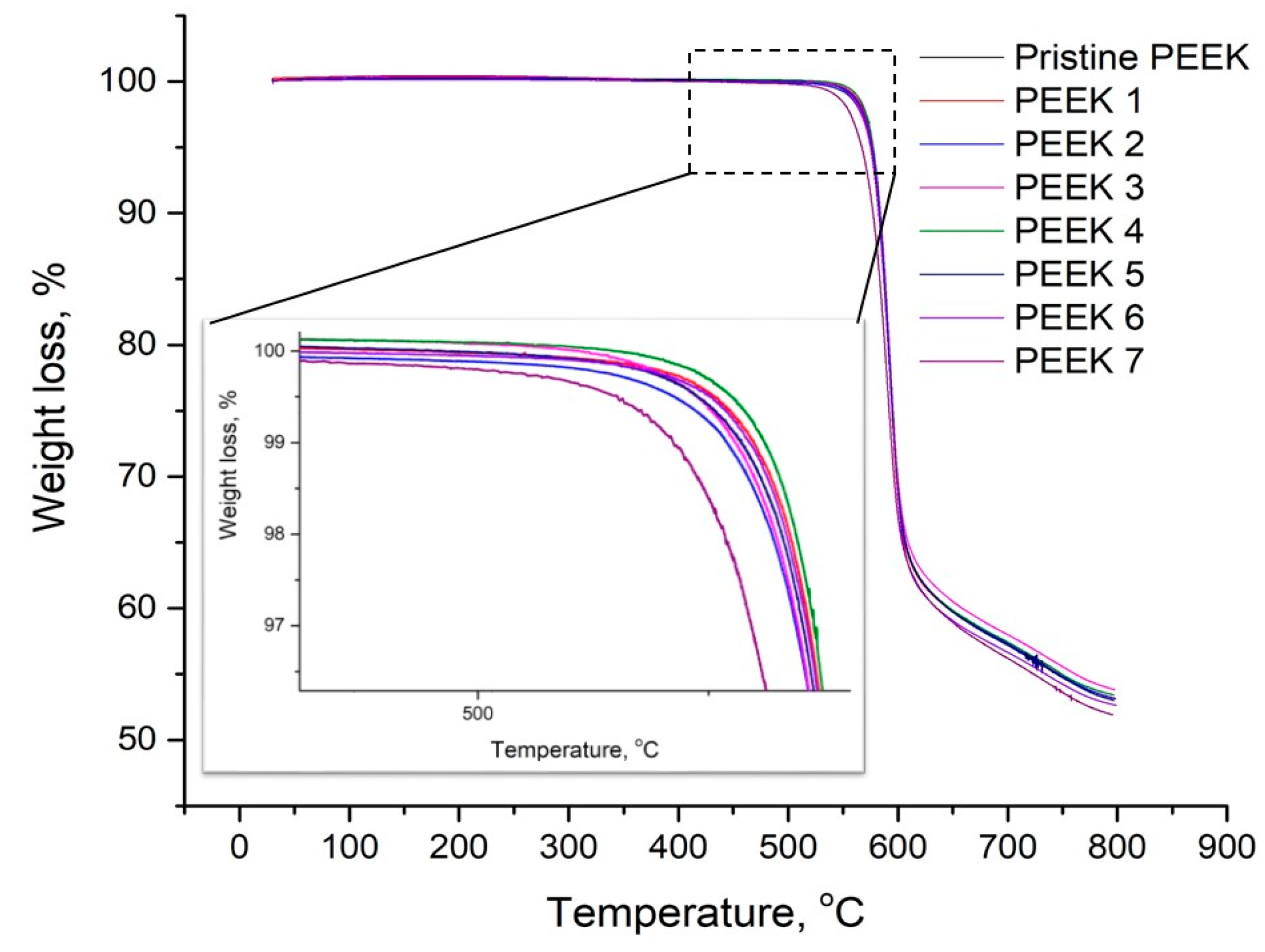
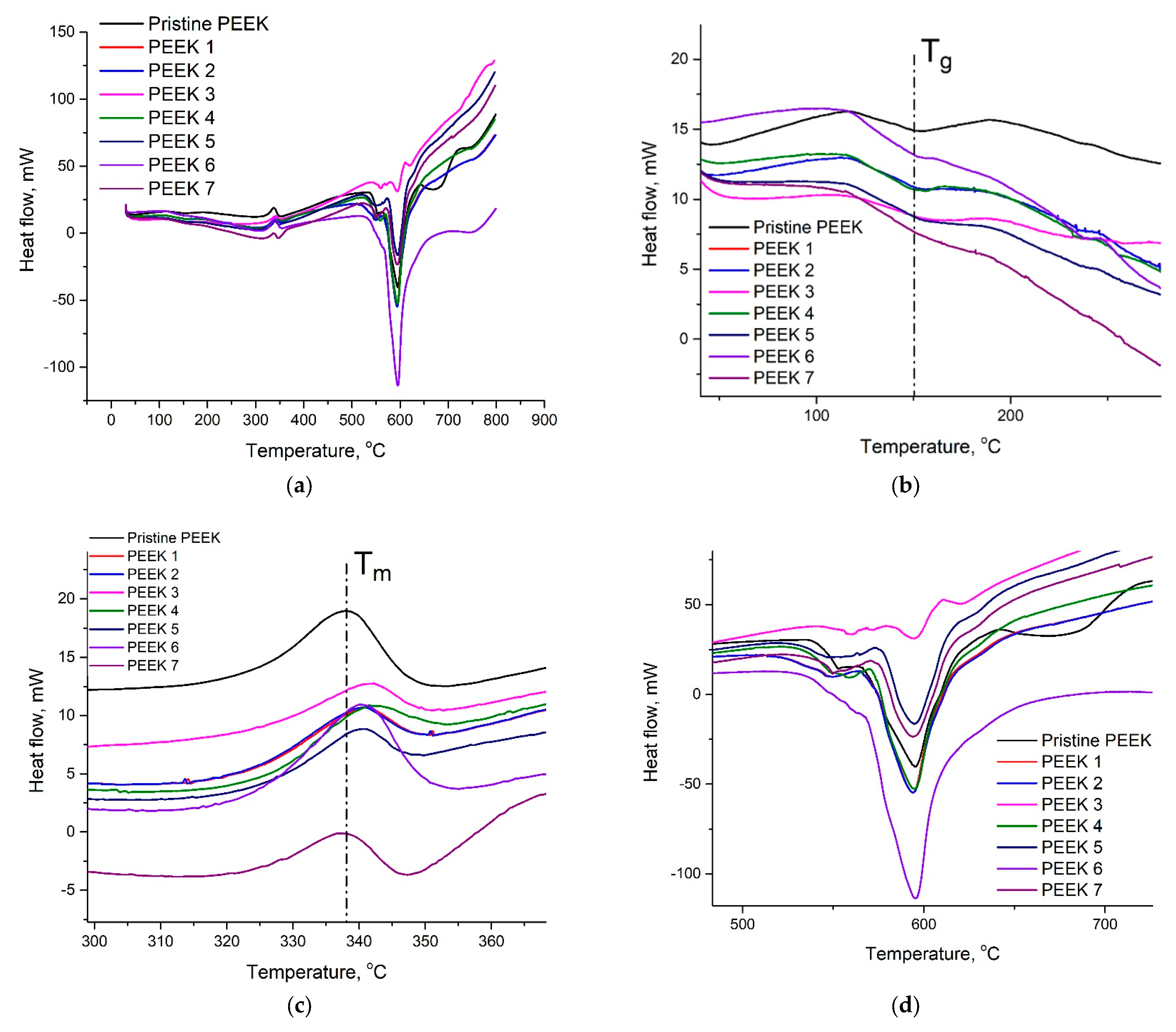
| Number of Samples | Energy, MeV | Beam Current, mА | Velocity, m/min | Number of Runs | Dose per Run, kGy | Total Dose, kGy |
|---|---|---|---|---|---|---|
| PEEK-1 | 2.7 | 6.84 | 9 | 5 | 10 | 50 |
| PEEK-2 | 2.7 | 6.84 | 9 | 10 | 10 | 100 |
| PEEK-3 | 2.7 | 6.84 | 9 | 20 | 10 | 200 |
| PEEK-4 | 2.7 | 6.84 | 0.8 | 2 | 100 | 200 |
| PEEK-5 | 2.7 | 6.84 | 9 | 30 | 10 | 300 |
| PEEK-6 | 2.7 | 6.84 | 0.8 | 3 | 100 | 300 |
| PEEK-7 | 2.7 | 6.84 | 9 | 40 | 10 | 400 |
| µ | Wear Rate (10−5 mm3/Nm) | Reference |
|---|---|---|
| 0.3 | 0.38 | [32] |
| 0.33 | 1.2 | [33] |
| 0.15–0.20 | 0.004 | [34] |
| 0.42 | [35] | |
| 0.3–0.42 | 0.1–04 | [36] |
| 0.41 | 1.2 | [37] |
| 0.34–0.42 | 1.1–2.5 | [38] |
| 0.49–0.61 | 0.16–35 | [39] |
| 0.18–0.30 | 0.45–2.2 | our results |
| Peak Position | Height | FWHM | d [Å] | Intensity [%] |
|---|---|---|---|---|
| 18.7316 | 504.15 | 0.3542 | 4.73732 | 100.00 |
| 20.7309 | 191.75 | 0.4133 | 4.28474 | 38.03 |
| 22.6433 | 240.63 | 0.4133 | 3.92701 | 47.73 |
| 28.6634 | 133.99 | 0.2952 | 3.11445 | 26.58 |
| Peak Position | Height | FWHM | d [Å] | Intensity [%] |
|---|---|---|---|---|
| 18.7233 | 487.15 | 0.3542 | 4.73941 | 100.00 |
| 20.7102 | 188.45 | 0.4133 | 4.28898 | 38.68 |
| 22.6043 | 223.03 | 0.7085 | 3.93369 | 45.78 |
| 28.7211 | 120.03 | 0.5904 | 3.10833 | 24.64 |
| Peak Position | Height | FWHM | d [Å] | Intensity [%] |
|---|---|---|---|---|
| 18.7153 | 473.77 | 0.4133 | 4.74140 | 100.00 |
| 20.7096 | 185.59 | 0.4723 | 4.28911 | 39.17 |
| 22.6457 | 222.31 | 0.3542 | 3.92660 | 46.92 |
| 28.7552 | 124.14 | 0.2952 | 3.10472 | 26.20 |
Disclaimer/Publisher’s Note: The statements, opinions and data contained in all publications are solely those of the individual author(s) and contributor(s) and not of MDPI and/or the editor(s). MDPI and/or the editor(s) disclaim responsibility for any injury to people or property resulting from any ideas, methods, instructions or products referred to in the content. |
© 2023 by the authors. Licensee MDPI, Basel, Switzerland. This article is an open access article distributed under the terms and conditions of the Creative Commons Attribution (CC BY) license (https://creativecommons.org/licenses/by/4.0/).
Share and Cite
Kurbanova, B.; Aimaganbetov, K.; Ospanov, K.; Abdrakhmanov, K.; Zhakiyev, N.; Rakhadilov, B.; Sagdoldina, Z.; Almas, N. Effects of Electron Beam Irradiation on Mechanical and Tribological Properties of PEEK. Polymers 2023, 15, 1340. https://doi.org/10.3390/polym15061340
Kurbanova B, Aimaganbetov K, Ospanov K, Abdrakhmanov K, Zhakiyev N, Rakhadilov B, Sagdoldina Z, Almas N. Effects of Electron Beam Irradiation on Mechanical and Tribological Properties of PEEK. Polymers. 2023; 15(6):1340. https://doi.org/10.3390/polym15061340
Chicago/Turabian StyleKurbanova, Bayan, Kazybek Aimaganbetov, Kanat Ospanov, Kairat Abdrakhmanov, Nurkhat Zhakiyev, Bauyrzhan Rakhadilov, Zhuldyz Sagdoldina, and Nurlan Almas. 2023. "Effects of Electron Beam Irradiation on Mechanical and Tribological Properties of PEEK" Polymers 15, no. 6: 1340. https://doi.org/10.3390/polym15061340
APA StyleKurbanova, B., Aimaganbetov, K., Ospanov, K., Abdrakhmanov, K., Zhakiyev, N., Rakhadilov, B., Sagdoldina, Z., & Almas, N. (2023). Effects of Electron Beam Irradiation on Mechanical and Tribological Properties of PEEK. Polymers, 15(6), 1340. https://doi.org/10.3390/polym15061340







